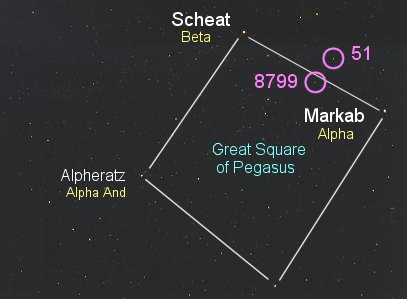 Four "super-Jupiter" planets are found to orbit the class A5 dwarf,
HR 8799. Along with Fomalhaut's planet, this quartet of
planets contains the first to be seen by direct imaging and the
first to be discovered orbiting a class A star.
Four "super-Jupiter" planets are found to orbit the class A5 dwarf,
HR 8799. Along with Fomalhaut's planet, this quartet of
planets contains the first to be seen by direct imaging and the
first to be discovered orbiting a class A star.
THE PLANETS
The lower circle shows the location of the class A5 dwarf star HR
8799, found in the constellation
Pegasus. Four giant planets are seen to orbit, HR 8799: "e",
"d", "c", and "b", at average distances from the star of 14.5, 24,
38, and 68 Astronomical Units. The first three were found in 2008,
the fourth ("e") in 2010. If placed here, around our Sun, the
inner one would be between the orbits of Saturn and Uranus, the
next one a bit inside the orbit of Neptune, while the third ("d")
would be near the average distance of Pluto. With respective
estimated masses of 9, 10, 10, and 7 times that of Jupiter, they
take roughly 50, 100, 190, and 465 years to make full orbits.
|
 Four "super-Jupiter" planets are found to orbit the class A5 dwarf,
HR 8799. Along with Fomalhaut's planet, this quartet of
planets contains the first to be seen by direct imaging and the
first to be discovered orbiting a class A star.
Four "super-Jupiter" planets are found to orbit the class A5 dwarf,
HR 8799. Along with Fomalhaut's planet, this quartet of
planets contains the first to be seen by direct imaging and the
first to be discovered orbiting a class A star.
 Four "super-Jupiter" planets are found to orbit the class A5 dwarf,
HR 8799. Along with Fomalhaut's planet, this quartet of
planets contains the first to be seen by direct imaging and the
first to be discovered orbiting a class A star.
Four "super-Jupiter" planets are found to orbit the class A5 dwarf,
HR 8799. Along with Fomalhaut's planet, this quartet of
planets contains the first to be seen by direct imaging and the
first to be discovered orbiting a class A star.